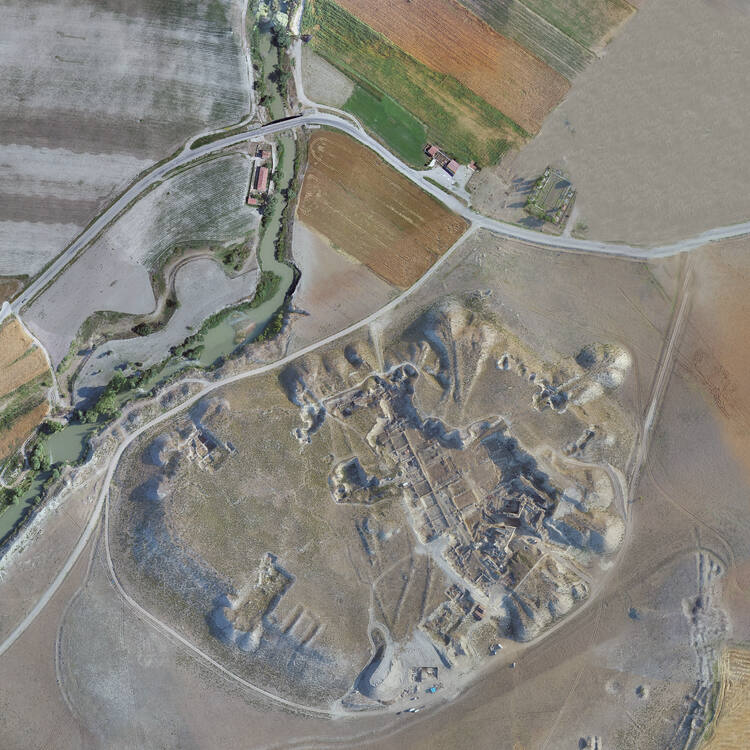Gordion
Gordion
Description is available under license CC-BY-SA IGO 3.0
Gordion
Description is available under license CC-BY-SA IGO 3.0
غورديون
source: UNESCO/CPE
Description is available under license CC-BY-SA IGO 3.0
戈尔迪翁
source: UNESCO/CPE
Description is available under license CC-BY-SA IGO 3.0
Гордион
source: UNESCO/CPE
Description is available under license CC-BY-SA IGO 3.0
Gordion
source: UNESCO/CPE
Description is available under license CC-BY-SA IGO 3.0
Outstanding Universal Value
Brief synthesis
The archaeological site of Gordion ranks as one of the most important historical centres in the ancient Near East. Gordion lies approximately ninety kilometres south-west of Ankara in central Türkiye, at the intersection of the great empires to the east (Assyrians, Babylonians, Hittites) and the west (Greeks, Romans). Consequently, it occupied a strategic position on nearly all trade routes that linked the Aegean and Mediterranean seas with the Near East. Gordion is an outstanding archaeological site for understanding the Phrygian civilisation and its achievements. The buildings of its Early Phrygian citadel, and the burial mounds of the city’s rulers, constitute the exceptional exemplars of monumental architecture in the Iron Age Near East.
The entrance to the Phrygian citadel features the best-preserved Iron Age (10th-8th centuries BCE) fortified gate complex that has yet been discovered, with stone masonry still preserved to a height of ten metres. The elite buildings within the citadel feature the earliest known coloured floor mosaics. The citadel’s industrial quarter, or Terrace Complex, was dedicated to large-scale food preparation and the production of textiles. With a length of over a hundred metres, the complex is without parallel in the ancient world. The roofing systems of the citadel’s buildings featured timber beams over ten metres in length with no internal supports, which is a daring, unparalleled feat of engineering for the period. The large concentration of monumental tumuli in the vicinity of Gordion creates an exceptional landscape of power, different from any other site in the Near East. The largest of the tumuli, the “Midas Mound” (Tumulus MM), rises to a height of fifty-three metres and the burial chamber within is the oldest known standing wooden building in the world (ca. 740 BCE), and inside it was found the best-preserved wooden furniture known from antiquity.
Criterion (iii): Gordion was the political and cultural centre of ancient Phrygia and today it represents the best surviving testimony to Phrygian civilisation, an Iron Age civilisation which developed in Anatolia and excelled in timber construction, woodcarving and metalwork.
Integrity
The property fully includes all the attributes that reflect its Outstanding Universal Value and is large enough for the context of these to be properly appreciated and understood. A long-term conservation programme under implementation ensures that an appropriate state of conservation is progressively achieved for all excavated areas. The tumuli and the unexcavated areas are overall in good condition, although smaller tumuli suffer from the effects of deep-ploughing. Measures are being envisaged to prevent their further erosion.
Authenticity
The level of authenticity of all attributes of the property is high. Seventy years of excavation and research have revealed a remarkable quality, quantity, and variety of archaeological remains, with high levels of preservation. There has been in situ consolidation work on parts of the structures on the Citadel Mound. The substantial amount of data recovered from the archaeological excavations has ensured that the archaeological remains subject to stabilisation/consolidation work retain a high level of authenticity in terms of material and design. All stabilisation work has been based on complete and detailed documentation.
Protection and management requirements
The property has the highest level of site designation, having been designated as a 1st and 3rd degree archaeological conservation area by the Decision No.1096, 16/02/1990 of the Ankara Regional Council for Conservation of Cultural and Natural Properties. In addition, the status of 3rd degree archaeological conservation area designation ensures that the immediate setting of the Citadel Mound at the west and north peripheries is protected from adverse development. This is also protected and managed within the framework of the Protection of Cultural and Natural Properties Law n. 2863/1983.
The buffer zone is protected through national, regional, or local plans and through its designation as agricultural land, subject to provisions of the Soil Protection and Land-Use Law n. 5403/2005. The wider setting is covered by District Rural Settlement Development Plans. A management system and mechanisms are in place and include a management plan: its implementation through a participative approach towards the local community will guarantee its effectiveness.
Proactive measures to prevent looting and mechanisms to support the farming community vis-à-vis the necessary restrictions to preserve buried archaeological deposits are key for the long-term sustenance of the integrity and authenticity of the attributes of Gordion’s Outstanding Universal Value, as is the preservation of the rural character of its immediate and wider setting.
